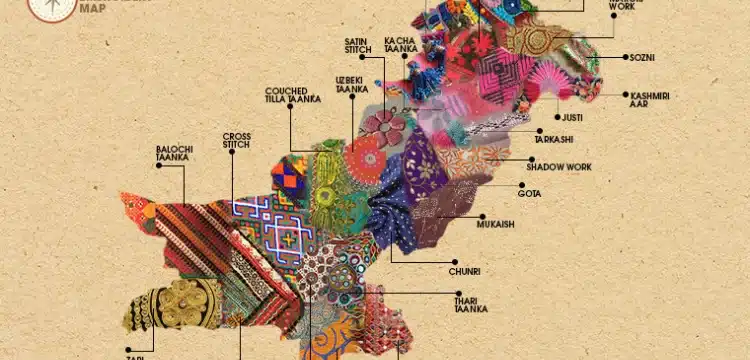[vc_row][vc_column][vc_column_text dp_text_size=”size-4″]Pakistan has a plethora of hand-embroidered crafts that are founded in the country’s cultural heritage and traditional abilities. Pakistan boasts a multitude of needlework styles and techniques that have been passed down from generation to generation, ranging from the vividly coloured flower patterns of Phulkari to the intricate geometric motifs of Balochi stitching.
Many of these embroidery techniques are linked to specific places or populations in Pakistan, and they frequently represent the natural beauty, cultural legacy, and social conventions of those areas. Pakistani hand-embroidered crafts, whether used to embellish garments, accessories, or household goods, are a monument to the country’s craftsmen’ originality, talent, and craftsmanship.
Chikankari
Chikankari is a type of embroidery that is primarily done on lightweight cotton cloth. Chikankari embroidery is delicate, white-on-white needlework that is frequently accentuated with coloured threads.

Phulkari
Phulkari is a type of traditional needlework that originated in Punjab, Pakistan. It is well-known for its brightly coloured flower motifs and is typically done on coarse cotton cloth.

Tarkashi
Fine wires, usually made of silver or gold, are inlaid into the fabric to form elaborate patterns and designs in this needlework. The complex and delicate beauty of embroidery gives a touch of elegance and glamour to any garment or accessory.

Gota Patti
Gota Patti or Gota work is a type of needlework in which small bits of ribbon or gota are attached to the fabric to create elaborate shapes and patterns. The gota is fastened to the fabric by a running stitch and is frequently paired with various types of embroidery including zari, sequin, and bead work.

Aari work
Aari or Zari needlework is often done on silk, cotton, or velvet textiles and displays exquisite motifs and patterns, frequently embellished with metallic threads and beads. The embroidery is done by tightly stretching the fabric on a frame and then using the aari needle to form chain stitches from the underside of the fabric. The patterns are frequently symmetrical and repetitious, with floral and paisley elements.

Mirror work
Mirror work is a famous needlework technique in Pakistan. It has little mirrors connected to the fabric with embroidery thread. The mirrors reflect light, creating a shimmering appearance on the embroidery.

Zardozi
The term ‘Zardozi’ is derived from the Persian terms ‘Zar’ for gold and ‘Dpzi’ for embroidery, and the technique involves the use of metallic threads, beads, and sequins to create elaborate designs on fabric.

Balochi embroidery
Balochi embroidery is a type of traditional needlework practised by the Baloch people of Balochistan. It has brilliantly coloured threads and elaborate patterns that are frequently influenced by nature.

Parsi Gara
Parsi Gara Gara embroidery is a traditional Chinese needlework style that is now popular in Pakistan. It usually has elaborate designs that are embroidered into silk fabric with vividly coloured threads. Parsi Gara saris are famous for their elaborate stitching. Gara was introduced to the Subcontinent by Parsi businessmen who used to deal with China. Traditional Chinese Garas were particularly heavy to wear since they featured embroidered borders on all four sides.
 [/vc_column_text][/vc_column][/vc_row]
[/vc_column_text][/vc_column][/vc_row]











